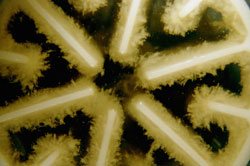Illuminati
July 13th, 14th, in France and all summer long, millions will gather at night to cheer fervently fireworks.
Fireworks are the simulacrum and the ersatz of war. Vertical flares pollute the sky and horizontal flares are used as weapons.
OSPAR loses the Arctic
Report
OSPAR comes from the fusion in 1992 of the Paris Convention for the Prevention of Marine Pollution from Land-based Sources and the Oslo Convention for the Prevention of Marine Pollution by navy and aircraft immersion operations. The latter was initiated following the shock of the oil spill from the Torrey Canyon March 18, 1967.
OSPAR is dedicated to the protection of the northeast Atlantic Ocean. It is a pilot fish. The work of its 5 committees – Biodiversity, Offshore Industry, Radioactive Substances, Environmental Impact of Human Activities, Hazardous Substances and Eutrophication – allows better understanding and combat of the many pressures on marine ecosystems from the open sea of Portugal to the Arctic Ocean. This success is notably materialized by a quality status report without concession of the OSPAR zone in 2010 (1). Seven years later, the OSPAR pilot fish is threatened of asphyxia by the Arctic countries. Robin des Bois has returned from the Biodiversity and Offshore Industry committees which gathered in Berlin and in Oslo the first two weeks of March.
Millions of Stowaway Passengers Circling Around the Pacific Ocean
The tsunami which followed the Japanese earthquake devastated around 300km of coastal cities, towns, farmlands and greenhouses along Japan’s Pacific coastline. The wave was reported to have spread up to 10km (six miles) inland and inundated around 500km². Not only did the earthquake and tsunami create an estimated 25 million tonnes of rubble, but when the tsunami receded it dragged with it countless quantities of waste in the flooded zone.
A Plastic Sea in the Seine River
 Millions of polypropylene widgets used to attract bacteria in wastewater treatment plants are drifting along in the Seine after being dumped by either the Essonne Intercommunal Union for Sanitation and River Restoration (1) or its subcontractors.
Millions of polypropylene widgets used to attract bacteria in wastewater treatment plants are drifting along in the Seine after being dumped by either the Essonne Intercommunal Union for Sanitation and River Restoration (1) or its subcontractors.
The Norwegian inventor describes the technology as “a 3-room apartment with a kitchen where bacteria can live comfortably and eat pollutants in wastewater.” The technology, described in France as Radical Flow Fluidized Filter (R3F), is considered easy and economical to operate. The lifespan of the “biomedias” (2) is 20 to 25 years. They are used in Bordeaux, Mulhouse and upstream of Paris, to name a few locations. These bacteria niches can amount to 19 million units per 100 m3 of water. Operators have obviously released them in large numbers into the natural environment.
















